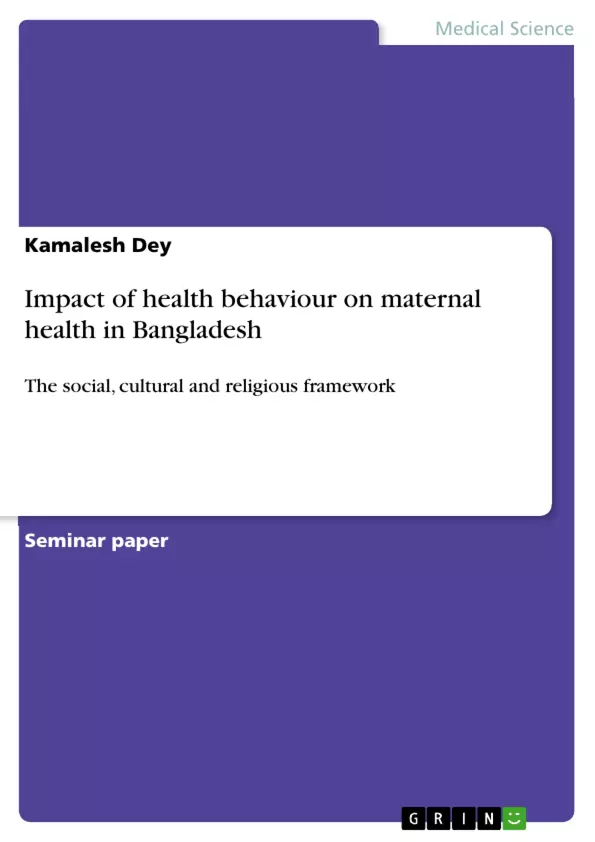The essay will talk about maternal health and health behaviour in Bangladesh. It will also critically explore the actual fact in Bangladesh, how maternal health is influenced by their health behaviour based on social, cultural and religious framework. Moreover, it will also highlight governmental strategy for improving maternal health which will be an outstanding achievement of the “Millennium Development Goal (MDG) 5” in Bangladesh.
Maternal health is the prime concern of public health in Bangladesh. After that, Bangladesh is highly motivated to achieve its “Millennium Development Goal (MDG) 5” for improving maternal health and reducing the maternal mortality rate by 75% between the period of 1990 and 2015. Bangladesh’s government is promoting a safe maternity practice and reducing maternal mortality. Already, the government has been expanded and has promoted existing health services, implementing them with a new policy and services performing EOC (essential obstetric care), accessible to all women particularly pregnant mothers and adolescents.
Moreover, Bangladesh is a highly populated developing country in the world with a maternal mortality ratio of 170/100,000 live births. Particularly, prenatal and postnatal care is very poor in Bangladesh because of malnutrition. It is stated that in Bangladesh the maternal mortality and morbidity rate is the second highest in the world. There are several influential factors, for instance: indigenous health behaviour and traditional lifestyle which are remarkably based on social, cultural and religious belief. In Bangladesh, around 20,000 mothers are dying each year during their pregnancy, while 69% are from obstetric causes, 14% are as a result of injury and violence and the rest due to indirect deaths.
Inhaltsverzeichnis (Table of Contents)
- INTRODUCTION
- MATERNAL HEALTH
- HEALTH BEHAVIOUR
- Education and Freedom
- Poverty
- Income and social class
- Occupation
- Culture
- Religion
- Access and Utilisation of Maternal Health in Bangladesh
- GOVERNMENT INTERVENTIONS
- CONCLUSION
- REFERENCES
Zielsetzung und Themenschwerpunkte (Objectives and Key Themes)
This essay examines maternal health and health behavior in Bangladesh, focusing on how social, cultural, and religious factors influence maternal health outcomes. It also explores the impact of government interventions on achieving the Millennium Development Goal 5 (MDG 5) for improving maternal health and reducing maternal mortality in Bangladesh.
- The influence of social, cultural, and religious factors on maternal health in Bangladesh.
- The impact of poverty and socioeconomic status on maternal health access and utilization.
- The role of education and awareness in improving maternal health practices.
- The effectiveness of government interventions in promoting safe maternity practices and reducing maternal mortality.
- The progress and challenges in achieving the Millennium Development Goal 5 (MDG 5) in Bangladesh.
Zusammenfassung der Kapitel (Chapter Summaries)
The introduction provides an overview of the essay's focus on maternal health and health behavior in Bangladesh. It highlights the country's commitment to achieving MDG 5 and the challenges it faces in reducing maternal mortality.
The chapter on "Maternal Health" defines maternal health according to WHO and discusses the key indicators used to measure it. The chapter also examines the major direct and indirect causes of maternal morbidity and mortality in Bangladesh, including postpartum haemorrhage, eclampsia, and domestic violence.
The "Health Behaviour" section delves into the social, cultural, and religious factors that influence maternal health practices in Bangladesh. It explores the role of education, income, occupation, social class, culture, and religion in shaping health decisions and behaviors.
Schlüsselwörter (Keywords)
The key terms and concepts explored in this essay include maternal health, health behaviour, social determinants of health, poverty, education, culture, religion, access to healthcare, maternal mortality, Millennium Development Goal 5 (MDG 5), Bangladesh, government interventions, and safe maternity practices. The essay focuses on understanding the complex interplay of these factors and their impact on maternal health outcomes in Bangladesh.
- Citation du texte
- Kamalesh Dey (Auteur), 2015, Impact of health behaviour on maternal health in Bangladesh, Munich, GRIN Verlag, https://www.grin.com/document/333873



